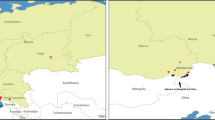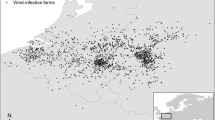Foot-and-mouth disease (FMD) is a highly contagious disease of livestock that has serious consequences on livestock production and trade. In Australia, preparedness and planning includes the development of decision-support tools that would assist priority setting and resource management in the event of an incursion. In this paper we describe an integrated modelling approach using geographic information system (GIS) technology to assess the risk of wind-borne spread of FMD virus. The approach involves linking an intra-farm virus production model, a wind transport and dispersal model, and an exposure-risk model to identify and rank farms at risk of wind-borne infection of FMD. This will assist authorities by enabling resources for activities like surveillance and vaccination to be allocated on the basis of risk.
Similar content being viewed by others
References
M.G. Garner, B.S. Fisher and J.G. Murray, Economic aspects of foot and mouth disease: perspectives of a free country, Australia, Rev. Sci. Tech. Off. Int. Epizoot. 21 (2002) 625–635.
A.D. James and J. Rushton, The economics of foot and mouth disease, Rev. Sci. Tech. Off. Int. Epizoot. 21 (2002) 637–644.
Productivity Commission, Impact of a Foot and Mouth Disease Outbreak on Australia, Research Report (AusInfo, Canberra, 2002).
G. Davies, The foot and mouth disease (FMD) epidemic in the United Kingdom 2001, Comp. Immunol. Microbiol. Infect. Dis. 25 (2002) 331–343.
A. Bouma, A.R.W. Elbers, A. Dekker, A. de Koeijer, C. Bartels, P. Vellema, P. van der Wal, E.M.A. van Rooij, F.H. Pluimers and M.C.M. de Jong, The foot-and-mouth diseases epidemic in the Netherlands in 2001, Prev. Vet. Med. 57 (2003) 155–166.
R.M. Cannon and M.G. Garner, Assessing the risk of wind-borne spread of foot-and-mouth disease in Australia, Environ. Int. 25 (1999) 713–723.
W.A. Geering, A.J. Forman and M.J. Nunn, Foot-and-mouth disease, in: Exotic Diseases of Animals: a field guide for Australian veterinarians (Australian Government Publishing Service, Canberra, 1995) pp. 112–131.
A.I. Donaldson, Epidemiology of foot-and-mouth disease: the current situation and new perspectives, in: Diagnosis and Epidemiology of Foot-and-Mouth Disease in Southeast Asia, eds. J.W. Copland, L.J. Gleeson and C. Chamnanpood (Australian Centre for International Agricultural Research, Canberra, 1994) pp. 9–15.
J.H. Sørensen, D.K.J. Mackay, C.Ø. Jensen and A.I. Donaldson, An integrated model to predict the atmospheric spread of foot-and-mouth disease virus, Epidemiol. Infect. 124 (2000) 577–590.
A.I. Donaldson and S. Alexandersen, Predicting the spread of foot and mouth disease by airborne virus, Rev. Sci. Tech. Off. Int. Epizoot. 21 (2002) 569–575.
T. Mikkelsen, S. Alexandersen, P. Astrup, H.J. Champion, A.I. Donaldson, F.N. Dunkerley, J. Gloster, J.H. Sørensen and S. Thykier-Nielsen, Investigations of airborne foot-and-mouth disease virus transmission during low-wind conditions in the early phase of the UK 2001 epidemic, Atmos. Chem. Phys. Discuss. 3 (2003) 677–703.
J. Gloster, J. Blackall, R.F. Sellers and A.I. Donaldson, Forecasting the spread of foot-and-mouth disease, Vet. Rec. 108 (1981) 370–374.
J. Gloster, R.F. Sellers and A.I. Donaldson, Long distance transport of foot-and-mouth disease over the sea, Vet. Rec. 110 (1982) 47–52.
F. Moutou and B. Durand, Modelling the spread of foot-and-mouth disease virus, Vet. Res. 25 (1994) 270–285.
J.S. Salt, The carrier state in foot and mouth disease – an immunological review, Br. Vet. J. 149 (1993) 207–223.
Kitching R.P., Hutber A.M. and Thrusfiled M.V. (2004) A review of foot-and-mouth disease with special consideration for the clinical and epidemiological factors relevant to predictive modelling of the disease, Vet. J. 169 (2005) 197–209.
Animal Health Australia, Disease Strategy: Foot-and-Mouth Disease (Version 3.0). Australian Veterinary Emergency Plan (AUSVETPLAN), 3rd edn (Animal Health Australia, Canberra, ACT, 2003).
A.D. James and P.B. Rossiter, An epidemiological model of rinderpest: I. Description of the model, Trop. Anim. Health Prod. 21 (1989) 59–68.
N.P. French, L. Kelly, R. Jones and D. Clancy, Dose–response relationships for foot and mouth disease in cattle and sheep, Epidemiol. Infect. 128 (2002) 325–332.
Ministry of Agriculture Fisheries and Forestry, Foot-and-mouth disease. Ageing of lesions. Reference Book 40. (HMSO, London, 1986).
AVIS consortium (2002) Foot and mouth disease (FMD) 2002. http://aleffgroup.com/avisfmd/index.html. Accessed 8 September 2004.
R.R. Draxler and G.D. Hess, Description of the HYSPLIT_4 Modeling System. NOAA Tech. Mem. ERL ARL-224 (Air Resources Laboratory, Silver Spring, MD, 1997).
R.R. Draxler and G.D. Hess, An overview of the HYSPLIT_4 modelling system for trajectories, dispersion and deposition, Aust. Meteorol. Mag. 47 (1998) 295–308.
K. Puri, G. Dietachmayer, G.A. Mills, N.E. Davidson, R.A. Bowen and L.W. Logan, The new BMRC Limited Area Prediction System, LAPS, Aust. Met. Mag. 47 (1998) 203–223.
L.H. Kantha and C.A. Clayson, Small Scale Processes in Geophysical Fluid Flows, Vol. 67, International Geophysics Series (Academic Press, San Diego, CA, 2000).
J.R. Garratt, The Atmospheric Boundary Layer. (Cambridge University Press, Cambridge, 1992).
B. Fay, H. Glaab, I. Jacobsen and R. Schrodin, Evaluation of Eulerian and Lagrangian atmospheric transport models at the Deutscher Wetterdienst using ANATEX surface tracer data, Atmos. Environ. 29 (1995) 2485–2497.
J. Casal, J.M. Moesco, E. Planas-Cuchí and J. Casal, Simulated airborne spread of Aujeszky's disease and foot-and-mouth disease, Vet. Rec. 140 (1997) 672–676.
A.I. Donaldson and S. Alexandersen, Relative resistance of pigs to infection by natural aerosols of FMD virus, Vet. Rec. 148 (2001) 600–602.
P. Sutmoller and D.J. Vose, Contamination of animal products: the minimum pathogen dose required to initiate infection, Rev. Sci. Tech. Off. Int. Epizoot. 16 (1997) 30–32.
C.F. Gibson and A.I. Donaldson, Exposure of sheep to natural aerosols of foot-and-mouth disease virus, Res. Vet. Sci. 41 (1986) 45–49.
A.I. Donaldson, C.F. Gibson, R. Oliver, C. Hamblin and R.P. Kitching, Infection of cattle by airborne foot and mouth disease virus: minimal doses with O1 and SAT2, Res. Vet. Sci. 43 (1987) 339–346.
S.W. Martin, A.H. Meek and P. Willeberg, Veterinary Epidemiology. Principles and Methods, 1st edn. (Iowa State University Press, Ames, USA, 1987).
R.G. Sargent, Verification and validation of simulation models, in: Proceedings of the 1998 Winter Simulation Conference, eds. D.J. Medeiros, E.F. Watson, J.S. Carson and M.S. Manivannan. (Washington DC, USA, 1988), pp. 121–130.
W.M. Miller, A state-transition model of epidemic foot-and-mouth disease. Technical Report No. 7, in: Potential Economic Impact of Foot-and-Mouth Disease in the United States (United States Government Printing Office, Washington DC, 1979).
T.E. Carpenter, Microcomputer programs for Markov and modified Markov chain disease models, Prev. Vet. Med. 5 (1988) 169–179.
A.M. Hutber and R.P. Kitching, The use of vector transition in the modelling of intraherd foot-and-mouth disease, Environ. Ecol. Stat. 3 (1996) 245–255.
B. Durand and O. Mahul, An extended state-transition model for foot-and-mouth disease epidemics in France, Prev. Vet. Med. 47 (1999) 121–139.
K.D.C. Stärk, D.U. Pfeiffer and R.S. Morris, Within-farm spread of classical swine fever virus – a blueprint for a stochastic simulation model, Vet. Q. 22 (2000) 36–43.
R.R. Draxler and G.D. Hess, An Overview of the HYSPLIT_4 modelling system for trajectories, dispersion and deposition, Aust. Meteorol. Mag. 47 (1998) 295–308.
G.D. Hess, G.A. Mills and R.R. Draxler, Comparison of HYSPLIT_4 model simulations of the ETEX data, using meteorological input data of differing spatial and temporal resolution, Proceedings ETEX Symposium on Long-Range Atmospheric Transport, Model Verification and Emergency Response, 13–16 May, Vienna, Austria, 1997.
M.E. Hugh-Jones, Epidemiological studies on the 1967–68 foot and mouth epidemic: attack rates and cattle density, Res. Vet. Sci. 13 (1972) 411–417.
R.F. Gloster and J. Gloster, The Northumberland epidemic of foot-and-mouth disease, 1966, J. Hyg. Camb. 85 (1980) 129–140.
M.J. Keeling, M.E.J. Woolhouse, D.J. Shaw, L. Matthews, M. Chase-topping, D.T. Haydon, S.J. Cornell, J. Kappey, J. Wilesmith and B.T. Grenfell, Dynamics of the 2001 UK foot and mouth epidemic: stochastic dispersal in a heterogenous landscape, Science 294 (2001) 813–817.
M.E. Hugh-Jones, Studies on the 1967–68 foot-and-mouth disease epidemic. The relation of weather to the spread of disease, J. Hyg. Camb. 68 (1970) 253–271.
A.I. Donaldson, S. Alexandersen, J.H. Sørensen and T. Mikkelsen, Relative risks of the uncontrollable (airborne) spread of FMD by different species, Vet. Rec. 148 (2001) 602–604.
S. Alexandersen, M. Quan, C. Murphy, J. Knight and Z. Zhang, Studies of quantitative parameters of virus excretion and transmission in pigs and cattle experimentally infected with foot-and-mouth disease virus. J. Comp. Pathol. 129 (2003) 268–282.
Author information
Authors and Affiliations
Corresponding author
Rights and permissions
About this article
Cite this article
Garner, M.G., Hess, G.D. & Yang, X. An integrated modelling approach to assess the risk of wind-borne spread of foot-and-mouth disease virus from infected premises. Environ Model Assess 11, 195–207 (2006). https://doi.org/10.1007/s10666-005-9023-5
Received:
Accepted:
Published:
Issue Date:
DOI: https://doi.org/10.1007/s10666-005-9023-5




